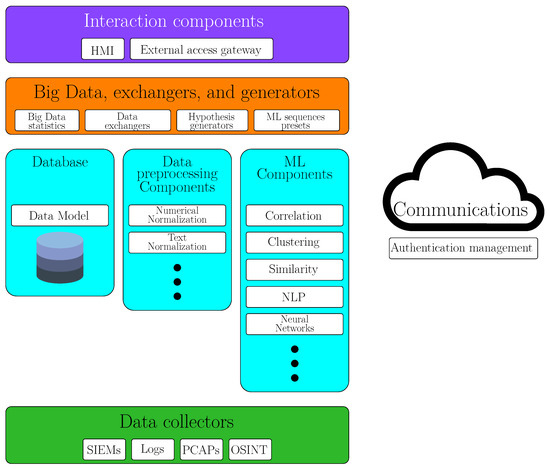
Introduction to Python for Cybersecurity
In the world of cybersecurity, staying one step ahead of hackers and protecting your digital assets is crucial. With the ever-evolving threat landscape, having the right tools and skills is essential. That’s where Python comes in.
Brief overview of Python and its relevance in cybersecurity
Python is a versatile programming language known for its simplicity and readability. It has gained popularity in the cybersecurity community due to its extensive library support and ease of use. Here are some reasons why Python is widely used in cybersecurity:
- Automation: Python’s simplicity allows cybersecurity professionals to automate repetitive tasks, such as analyzing logs, scanning for vulnerabilities, or performing network scans. This saves time and effort, allowing for more effective threat detection and response.
- Data Analysis: Python’s rich ecosystem of libraries, such as Pandas and NumPy, make it an excellent choice for analyzing large datasets. Cybersecurity professionals can use Python to extract insights from log files, network traffic data, or security event logs.
- Scripting: Python’s scripting capabilities make it a powerful tool for creating custom scripts to automate specific tasks or interact with various security tools and APIs. This flexibility allows for greater customization and integration with existing tools and systems.
- Penetration Testing: Python provides a range of libraries and frameworks, like Scapy and Metasploit, that are widely used in penetration testing activities. These tools enable professionals to identify vulnerabilities in systems and simulate real-world attacks to strengthen security defenses.

Foundations of Cybersecurity
With the increasing prevalence of cyber threats and attacks, it has become crucial for individuals and businesses to prioritize their digital security. Understanding the foundations of cybersecurity is essential in protecting your digital world.
Overview of cybersecurity concepts and principles
Cybersecurity encompasses a range of practices, strategies, and technologies designed to protect computers, networks, and data from unauthorized access or damage. This includes measures such as firewall protection, encryption, and intrusion detection systems. The field of cybersecurity focuses on identifying vulnerabilities, mitigating risks, and preventing cyber attacks.
How Python can be used to enhance cybersecurity practices
Python, a powerful and versatile programming language, can play a significant role in enhancing cybersecurity practices. Here are a few ways Python can be utilized:
- Automated Security Testing: Python offers a variety of tools and libraries that enable developers to automate security testing processes. This allows organizations to identify vulnerabilities in their systems efficiently.
- Network Monitoring: Python can be used to develop network monitoring tools that continuously analyze network traffic for suspicious activities or anomalies. These tools aid in detecting potential cyber threats in real-time.
- Data Analysis: Python’s extensive libraries for data analysis and machine learning enable organizations to identify patterns and anomalies in large data sets. This can help identify potential security breaches or threats.
- Web Application Security: Python frameworks like Django provide built-in security features that help developers build robust and secure web applications.
By leveraging the capabilities of Python, businesses can enhance their cybersecurity practices and protect their digital assets from potential threats and attacks. Remember to stay updated with the latest security practices and continuously assess your systems for vulnerabilities.

Python Libraries for Cybersecurity
Introduction to key Python libraries for cybersecurity, such as Scapy, PyCryptodome, and Pyrebase
When it comes to protecting your digital world from cyber threats, having the right tools in your arsenal is crucial. Fortunately, Python provides a wide range of powerful libraries that can help you strengthen your cybersecurity defenses. Here are three key Python libraries that you should know about:
1. Scapy: Scapy is a robust packet manipulation library that allows you to create, send, and capture network packets. With Scapy, you can perform tasks such as network scanning, packet sniffing, and even building custom networking tools. Its flexibility and extensive functionality make it a go-to library for many cybersecurity professionals.
2. PyCryptodome: PyCryptodome is a comprehensive cryptography library for Python. It supports various cryptographic algorithms and provides functions for encryption, decryption, hashing, and more. Whether you need to secure your data or implement secure communication protocols, PyCryptodome has you covered.
3. Pyrebase: Pyrebase is a Python interface for the Firebase platform, which offers cloud-based services for mobile and web applications. In the context of cybersecurity, Pyrebase can be used for secure data storage and authentication. It provides easy integration with Firebase’s security features, allowing you to build secure applications with ease.
These libraries are just the tip of the iceberg when it comes to Python’s capabilities in the field of cybersecurity. By leveraging these powerful tools, you can enhance your ability to protect your digital assets and defend against cyber threats. So if you’re looking to bolster your cybersecurity efforts, consider exploring these Python libraries and incorporating them into your toolkit.

Automating Security Tasks with Python
In a world where cyber threats are becoming increasingly sophisticated, it is crucial for organizations to find efficient ways to protect their digital assets. This is where Python comes in handy. Python is a versatile programming language that can be used to automate various security tasks, making it an invaluable tool for cybersecurity professionals.
Exploring how Python can be used to automate common security tasks, such as vulnerability scanning and log analysis
Python offers a wide range of libraries and frameworks that enable cybersecurity experts to automate repetitive and time-consuming tasks. Here are a few examples:
Vulnerability Scanning: Python can essentially write scripts that scan networks or web applications for vulnerabilities. By automating this process, organizations can identify and patch potential vulnerabilities before malicious actors can exploit the organizations must find.
Log Analysis: Analyzing logs is an essential part of detecting and responding to security incidents. Python enables security analysts to write scripts that parse and analyze logs from different sources. This helps them quickly identify abnormal activities or signs of compromise.
Password Cracking: While ethical hacking is an aspect of cybersecurity, manually cracking passwords can be time-consuming. Python provides libraries that facilitate password cracking, enabling professionals to test the strength of their systems and identify potential weaknesses.
Malware Analysis: Python can also be used for automating malware analysis tasks. By leveraging Python libraries, analysts can quickly analyze the behavior of suspicious files and identify any malicious activities.
By utilizing Python for automating security tasks, cybersecurity professionals can enhance their efficiency and effectiveness in protecting their digital world. It is important for organizations to invest in training their security teams in Python programming to take advantage of its capabilities in the rapidly evolving landscape of cybersecurity.
Web Security with Python
With the rapid advancement of technology, ensuring the security of your digital world has become more crucial than ever. Cybersecurity threats are continuously evolving, and organizations need to stay one step ahead to protect their data and infrastructure. Python, a powerful programming language known for its versatility and ease of use, can be a valuable tool in the fight against cyber threats.
Understanding how Python can be leveraged for web security, including web scraping, API security, and web application testing
- Web Scraping: Python provides libraries like Beautiful Soup and Scrapy that enable automated extraction of information from websites. This can be useful for gathering intelligence on potential vulnerabilities or monitoring online activities.
- API Security: Many web applications rely on APIs (Application Programming Interfaces) to communicate with external systems. Python can be used to assess the security of these APIs by performing vulnerability assessments, testing for unauthorized access, and ensuring data privacy.
- Web Application Testing: Python frameworks such as Django and Flask provide a robust foundation for building secure web applications. Additionally, tools like Selenium and OWASP ZAP can be leveraged for automated security testing of web applications.
By leveraging Python’s capabilities, organizations can enhance their web security efforts, strengthen their defenses against cyber threats, and protect their digital assets. Stay updated with the latest security practices and use Python programming language to protect our digital world.

Network Security with Python
Utilizing Python for network security tasks, such as network scanning, packet sniffing, and firewall configuration
In today’s digital world, cybersecurity has become a critical concern for individuals and businesses alike. Protecting your digital assets from potential threats and vulnerabilities is essential to maintaining the integrity of your network. One powerful tool that can assist you in this endeavor is Python.
Python, with its simplicity and versatility, has gained popularity among cybersecurity professionals for its ability to automate complex tasks and perform various network security functions. Here are some key ways in which Python can be utilized for network security:
- Network scanning: Python provides libraries such as Scapy and Nmap that allow you to perform network scans to identify potential vulnerabilities or unauthorized devices on your network.
- Packet sniffing: By utilizing tools like PyShark or Scapy, you can capture and analyze network traffic to detect any suspicious or malicious activities in real-time.
- Firewall configuration: Using Python, you can interact with firewall APIs to automate the configuration process, making it easier to manage access controls and protect your network from unauthorized access.
Python’s scripting capabilities enable cybersecurity professionals to automate repetitive tasks, allowing them to focus on more critical aspects of network security. Its extensive library support also provides access to a wide range of resources and tools specific to cybersecurity needs.
In conclusion, Python is a valuable asset in the field of cybersecurity. Python is great for network security tasks. It is simple, versatile, and has a lot of library support. It can be used for network scanning, packet sniffing, and configuring firewalls. By utilizing Python’s capabilities effectively, you can enhance the security of your digital world.

Data Analysis and Visualization for Cybersecurity
Cybersecurity is a critical concern in today’s digital world, and businesses need to employ effective strategies to protect their valuable data. Data analysis and visualization play a key role in identifying and mitigating potential threats. With its powerful libraries and tools, Python has become the go-to language for cybersecurity professionals.
Using Python for data analysis and visualization in cybersecurity, including threat intelligence and anomaly detection
Data analysis involves examining large data sets to uncover patterns, trends, and anomalies. Python offers libraries like pandas, NumPy, and SciPy that provide efficient and flexible data manipulation, aggregation, and statistical analysis tools. These libraries enable cybersecurity professionals to quickly extract valuable insights from massive amounts of data.
Visualization is essential for presenting complex data in a more accessible and understandable format. Python’s matplotlib and seaborn libraries allow for creating various visualizations such as bar charts, line graphs, scatter plots, heatmaps, and more. These visual representations aid in identifying patterns and outliers that may indicate potential security breaches.
Threat intelligence is another critical aspect of cybersecurity. With Python, professionals can utilize APIs to gather information from various sources like security feeds, open-source databases, and social media platforms. By analyzing this data using Python’s libraries and tools, they can identify emerging threats and take proactive measures to prevent them.
Anomaly detection is crucial for identifying suspicious activities or behaviors that deviate from normal patterns. Python provides machine learning libraries like scikit-learn and TensorFlow which can be used to develop anomaly detection models. These models can identify unusual network traffic, abnormal user behavior, or unauthorized access attempts.
In conclusion, Python’s capabilities in data analysis and visualization make it an indispensable tool for cybersecurity professionals. By leveraging these tools effectively, businesses can strengthen their defense against cyber threats and protect their digital assets.

Machine Learning and Artificial Intelligence in Cybersecurity
Introduction to machine learning and AI techniques with Python for cybersecurity applications, such as malware detection and intrusion detection
In today’s digitally connected world, the threat of cyber attacks has become a real and constant concern for both individuals and businesses. As technology advances, hackers are finding more sophisticated ways to breach security systems and exploit vulnerabilities. This is where machine learning and artificial intelligence (AI) can play a crucial role in cybersecurity.
Python is a popular programming language for cybersecurity because it is easy to use and has many libraries for data analysis and machine learning. With Python, you can apply various techniques to detect malware, identify network intrusions, and mitigate security risks.
Machine learning algorithms can analyze vast amounts of data to identify patterns and anomalies that may indicate a cyber attack. Training these models on historical data allows them to distinguish between normal and malicious activities. Python libraries such as Scikit-learn and TensorFlow provide pre-built functions and tools that simplify the implementation of machine learning algorithms for cybersecurity analysis.
Artificial intelligence techniques, such as natural language processing and image recognition, can analyze text-based threats or detect suspicious patterns in network traffic. Python’s libraries NLTK and OpenCV allow developers to incorporate AI capabilities into their cybersecurity solutions easily.

Conclusion
By now, you should understand the importance of branding for your business. Creating a strong brand identity is more than just having a catchy slogan or attractive logo. It’s about standing out from your competitors with reliability and strength. Here are the key points to remember:
Summary of the benefits of using Python for cybersecurity purposes
- Python is a versatile programming language that can be utilized for various cybersecurity purposes.
- It offers a wide range of libraries and frameworks that simplify developing secure applications.
- Python’s simplicity and readability make it ideal for beginners and experienced cybersecurity developers.
- With Python, you can automate tasks and streamline processes, improving your overall security posture.
- Its extensive community support ensures regular updates, bug fixes, and access to resources for enhancing cybersecurity practices.
Future trends and developments in Python for cybersecurity
As technology evolves, so does the field of cybersecurity. In the future, we can expect further enhancements and developments in Python for cybersecurity, including:
- Increased integration with machine learning and artificial intelligence algorithms for advanced threat detection and prevention.
- Expanded use of Python in areas such as network security, encryption, penetration testing, and vulnerability assessment.
- Continued efforts to improve Python’s performance, security features, and compatibility with different platforms and tools.
Overall, Python continues to be a powerful weapon in the battle against cyber threats. Its versatility, ease of use, and extensive community support make it an invaluable tool for protecting your digital world. So start harnessing the power of Python today and safeguard your business against potential cyber attacks.




